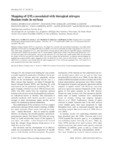Please use this identifier to cite or link to this item:
http://www.alice.cnptia.embrapa.br/alice/handle/doc/964041| Title: | Mapping of QTLs associated with biological nitrogen fixation traits in soybean. |
| Authors: | SANTOS, M. A.  GERALDI, I. O.   GARCIA, A. A. F.   BORTOLATTO, N.   SCHIAVON, A.   HUNGRIA, M.   |
| Affiliation: | MARIA APARECIDA SANTOS, ESALQ; ISAIAS OLÍVIO GERALDI, ESALQ; ANTONIO AUGUSTO FRANCO GARCIA, ESALQ; NÁGILA BORTOLATO, UNIFIL; ALINE SCHIAVON, UNIFIL; MARIANGELA HUNGRIA DA CUNHA, CNPSO. |
| Date Issued: | 2013 |
| Citation: | Hereditas, Lund, v. 150, n. 2-3, p. 17-25, 2013. |
| Description: | Biological nitrogen fi xation (BNF) is a key process, but despite the economic and environmental importance, few studies about quantitative trait loci (QTL) controlling BNF traits are available, even in the economically important crop soybean Glycine max (L.) Merr. In this study, a population of 157 F 2:7 RILs derived from crossing soybean cultivars Bossier (high BNF capacity) and Embrapa 20 (medium BNF capacity) was genotyped with 105 simple sequence repeat markers (SSRs). The genetic map obtained has 1231.2 cM and covers about 50% of the genome, with an average interval of 18.1 cM. Three traits, nodule number (NN), the ratio nodule dry weight (NDW)/NN and shoot dry weight (SDW) were used to evaluate BNF performance. A composite interval mapping for multiple traits method (mCIM) analysis mapped two QTLs for SDW (LGs E and L), three for NN (LGs B1, E and I), and one for NDW/NN (LG I); all QTLs were of small effect (R 2 -values ranging from 1.7% to 10.0%) and explained 15.4%, 13.8% and 6.5% of total variation for these three traits, respectively. |
| Thesagro: | Soja Fixação de nitrogênio |
| NAL Thesaurus: | Soybeans Nitrogen fixation |
| DOI: | 10.1111/j.1601-5223.2013.02275.x |
| Type of Material: | Artigo de periódico |
| Access: | openAccess |
| Appears in Collections: | Artigo em periódico indexado (CNPSO)  |
Files in This Item:
| File | Description | Size | Format | |
|---|---|---|---|---|
| j.16015223.2013.02275.x.pdf | 150,19 kB | Adobe PDF |  View/Open |









